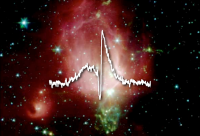›The Astrochemical Universe unveiled with Herschel
Since its launch in 2009, the Herschel Space Observatory has unveiled the far-IR window with its high sensitive instrumentation, collecting spectra of important molecules towards a variety of different objects: from comets to protoplanetary disks; from the diffuse interstellar medium and photodissociation regions (PDRs) to dense cloud cores; from star forming regions to the circumstellar environment of evolved stars; from local to early-universe galaxies. In doing so, new molecular species have been discovered; unbiased spectral surveys have unveiled an extraordinary rich chemistry; high spectral resolution line profiles of hydrates and important coolants such as water and carbon monoxide have revealed complex chemical/physical processes and shocked material. In summary, Herschel has emphasized the crucial role of astrochemistry in the whole astrophysical community. It is now time to summarize and compare the results obtained in different environments and to discuss their interpretation with the available models, with the aim of advancing our understanding of astrochemical processes in the universe.
This symposium consists of 5 blocks focused on Herschel spectroscopic and modelling results in different environments, plus one final block where astrochemical models will be presented and discussed. Schematically:
Block 1: Solar System and Evolved Stars
Block 2: The Interstellar Medium and Photodissociation Regions
Block 3: Star Forming Regions
Block 4: Protoplanetary disks
Block 5: External Galaxies
Block 6: Astrochemical models
The six sections will allow different communities to present their major results and discuss together common problems linked to the interpretation of Herschel observations. The final block will be dedicated to the data interpretation and available models. Here, open questions, major problems and future developments for data interpretation techniques and chemical/physical models will be jointly discussed.
Track this event on your Apple calendar














 Italy
Italy